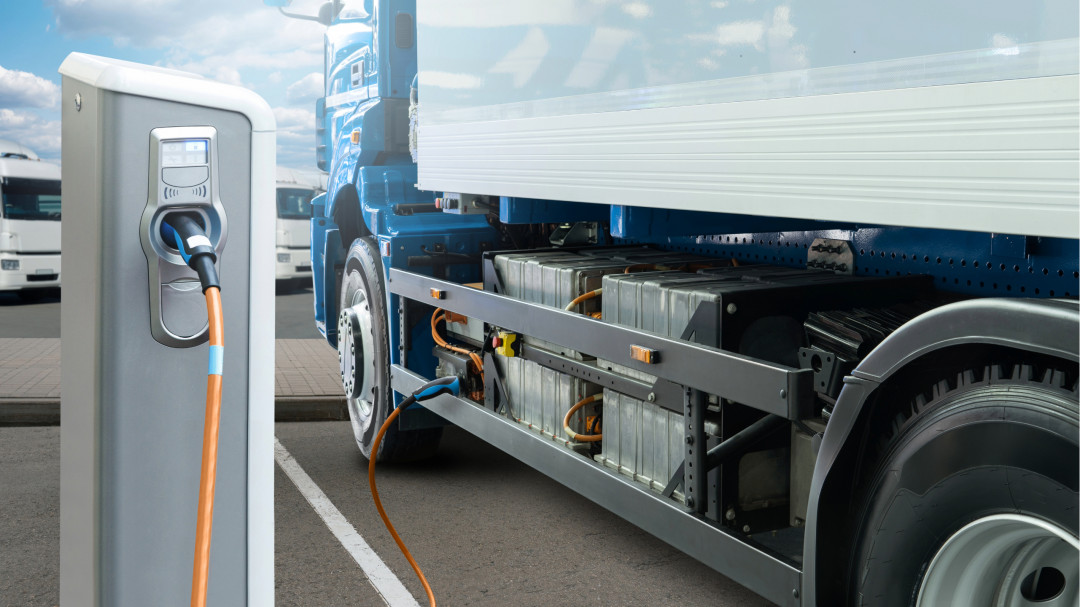
A joint study by Fraunhofer ISI and Amazon provides important insights into the optimal number and locations of public fast charging stations for long-distance truck traffic in Europe. Based on the calculated traffic volume for 2030 and 1.6 million truck journey combinations, the study analyses 20,000 potential locations for truck charging stations along European motorways using Amazon's open-source tool CHALET. The results show that as few as 1,000 public megawatt charging stations could be enough to cover 91 per cent of the expected long-distance traffic of electric trucks.
In order to reduce greenhouse gas emissions in the transport sector in general and heavy goods vehicles in particular, all EU member states will have to build up an infrastructure for alternative fuels in the coming years. This also includes the expansion of the public fast-charging infrastructure for trucks along motorways. An EU regulation already sets out specific minimum targets for the public truck charging infrastructure for all EU member states: for example, there should be a total of around 300 truck charging stations in Germany by 2030, and more than 2,000 across Europe. In view of the limited range of battery-electric trucks compared to diesel trucks, the question arises as to how many fast charging stations are needed in Europe.
However, there is still little knowledge about the optimal charging locations for long-distance truck transport in Europe. The study has therefore developed an optimised truck charging network based on calculations of European truck traffic in 2030, publicly accessible locations in Europe and existing truck stops, which covers the expected charging demand with a minimum number of charging stations. The study also takes into account capacity constraints in terms of space availability and grid connection, and calculates an optimised, step-by-step network expansion along the routes with the highest demand in Europe.
The results show that with a 15 per cent share of battery-powered trucks in the long-distance transport fleet, 1000 optimally selected charging stations distributed across Europe could cover 91 per cent of long-distance e-truck transport, while 500 stations could cover about half of the traffic. This is surprising, as the number of locations proposed in the study is lower than the EU's minimum infrastructure targets. The authors took a conservative approach in their calculations: They did not assume depot charging and based their calculations on a practical range of only 400 km, which some new battery-powered truck models already exceed today.
As far as the optimal locations for truck charging stations in Europe are concerned, the study recommends focusing on heavily travelled routes at important traffic hubs. If the charging network is expanded at a later date, locations on less heavily travelled routes can be added successively.
Dr Patrick Plötz, head of the Energy Industry business unit at Fraunhofer ISI and author of the study, emphasises: "The results show that even fewer charging locations than required by the European Union would cover almost all European e-truck traffic. However, these new locations must have sufficient network capacity, with some requiring a capacity of up to 12 megawatts to be able to supply up to 20 MCS connections. This highlights the challenges in terms of energy demand and network infrastructure that the electrification of European long-distance truck transport will bring with it. However, several European governments are already actively working on precisely these challenges.«
Patrick Plötz concludes that a strategically planned network based on megawatt charging stations could greatly promote the spread of battery-powered trucks in Europe: "Our research suggests that industry and policymakers need to accelerate the further development and introduction of megawatt charging systems such as MCS. This would enable logistics companies, for example, that do not have the option of depot charging to electrify their fleets. Public MCS stations could help to avoid challenges such as those related to the power supply or the acquisition of suitable real estate, which are often major obstacles to the purchase of battery-powered trucks.«
The study is part of the HoLa project, which is being funded by the Federal Ministry of Digital and Transport with a total of 12 million euros as part of the funding guideline for electromobility and is being carried out as a technology and testing project as part of the implementation of the "Overall Concept for Climate-Friendly Commercial Vehicles". Funding for this measure is also provided under the German Recovery and Resilience Plan (DARP) via the European Recovery and Resilience Facilities (ARF) in the NextGenerationEU programme. The funding guideline is coordinated by NOW GmbH and implemented by the Project Management Organisation Jülich (PtJ).
The analysis used Amazon's open-source tool CHALET, which helps industry, governments and local authorities to find optimal locations for electric vehicle charging infrastructure. It takes into account factors such as traffic flows, vehicle range and travel times to identify priority locations for e-truck charging points, thus accelerating the transition to a sustainable transport sector.

